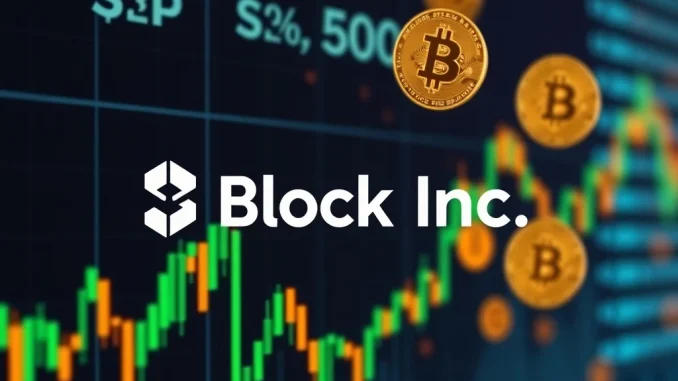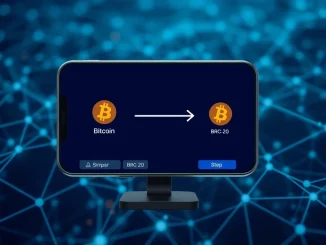
The financial world is buzzing with a groundbreaking development that signals a seismic shift in how traditional markets view digital assets. Block Inc., the innovative fintech powerhouse led by Bitcoin evangelist Jack Dorsey, has officially entered the prestigious S&P 500 index. This isn’t just news for Block; it’s a monumental leap for Bitcoin adoption, marking a pivotal moment where cryptocurrency-centric companies are recognized on Wall Street’s biggest stage.
A Pivotal Moment for Bitcoin Adoption in Traditional Finance
Block Inc.’s inclusion in the S&P 500 is more than just a corporate milestone; it’s a powerful statement about the evolving relationship between institutional finance and digital assets. As the third publicly traded entity—following MicroStrategy and Tesla—to hold substantial Bitcoin reserves while securing a spot in this iconic U.S. benchmark, Block’s move highlights a growing acceptance of crypto-centric operations within mainstream portfolios. This event signals a clear trend: accelerating Bitcoin adoption by major institutional players, indicating that digital assets are increasingly seen as viable and valuable components of a diversified financial landscape.
Understanding Block’s Strategic Move into the S&P 500
Block’s journey into the S&P 500 is a testament to its strategic emphasis on cryptocurrency adoption. The S&P 500, which tracks the largest publicly traded U.S. firms, requires a market capitalization above $18 billion, sufficient public float, and at least one profitable quarter for eligibility. Block not only met these stringent criteria but also showcased a treasury strategy that includes holding 8,584 BTC, valued at approximately $1 billion. This positions Block among the top 15 corporate Bitcoin holders globally. The news coincided with a 14% surge in Block’s stock price over the preceding week, reflecting renewed investor confidence as the company steps onto a larger stage. Block’s strategic decision to hold significant Bitcoin reserves played a key role in its profile, making its entry into the S&P 500 a landmark event for crypto.
The Rise of Institutional Crypto Players
The landscape of traditional finance is clearly changing with the rise of companies like Block. Block now joins Tesla and Coinbase in providing direct Bitcoin exposure through the S&P 500, amplifying the crossover between traditional finance and digital assets. This trend reflects a broader shift in market sentiment, where investors and regulators are increasingly viewing Bitcoin-related businesses as stable enough for blue-chip portfolios. The inclusion of Block, alongside other BTC-heavy firms, underscores the burgeoning influence of institutional crypto players in shaping market sentiment and driving further mainstream acceptance of digital assets.
Why Bitcoin Integration is Gaining Traction
The growing presence of Bitcoin-holding companies in major indices like the S&P 500 suggests a significant shift in how digital assets are perceived. Analysts suggest this signals a broader acceptance of Bitcoin integration into diverse investment portfolios, moving beyond its initial reputation as a volatile, speculative asset. While Bitcoin’s price volatility remains a concern for some, its adoption by high-profile firms and its inclusion in major indices suggests growing institutional acceptance as a potential hedge against macroeconomic uncertainties. Block’s integration into the index is expected to boost its liquidity and visibility, attracting both institutional and retail investors seeking exposure to the digital asset space through established market channels.
Block: A Bridge Between Fintech and Crypto
Block’s dual focus on traditional fintech services and crypto treasury management positions it as a vital bridge between legacy financial systems and decentralized technologies. The firm’s Square division, a key revenue driver, has demonstrated resilience in e-commerce and digital payments, reinforcing its relevance in the post-pandemic economy. Jack Dorsey has long advocated for Bitcoin’s potential to democratize finance, a vision now reinforced by Block’s elevated market status. Block’s unique position as a leader in both traditional fintech and crypto solutions highlights its role in connecting these two worlds. While critics caution that the inclusion of crypto-focused firms in the S&P 500 does not guarantee Bitcoin’s long-term stability, it undeniably underscores the index’s evolving composition, reflecting innovation in global markets. Regulatory clarity and technological advancements will remain critical for the asset’s future.
As Bitcoin’s presence on Wall Street expands, such inclusions may accelerate institutional adoption, further cementing digital assets in mainstream finance. Block’s entry into the S&P 500 is a significant milestone, not just for the company, but for the entire cryptocurrency ecosystem, signaling a future where digital assets are increasingly interwoven with the fabric of global finance.
Frequently Asked Questions (FAQs)
What does Block’s S&P 500 inclusion mean for Bitcoin?
Block Inc.’s entry into the S&P 500 is a major validation for Bitcoin, signaling increased institutional acceptance and mainstream recognition. It means more companies holding Bitcoin are now part of major traditional financial indices, potentially attracting broader investor interest and legitimizing digital assets.
How much Bitcoin does Block Inc. hold?
Block Inc. holds 8,584 BTC in its treasury, which was valued at approximately $1 billion at the time of the announcement. This significant holding places it among the top corporate Bitcoin holders globally.
Which other companies in the S&P 500 hold substantial Bitcoin?
Block Inc. joins MicroStrategy and Tesla as the third publicly traded entity in the S&P 500 that holds substantial Bitcoin reserves. Coinbase, while also in the S&P 500, is a cryptocurrency exchange rather than a corporate Bitcoin holder in the same treasury sense.
What are the S&P 500 eligibility requirements?
To be eligible for the S&P 500, a company must have a market capitalization above $18 billion, sufficient public float, and at least one profitable quarter, among other criteria. These requirements ensure only large, financially sound companies are included.
Will Block’s inclusion stabilize Bitcoin’s price?
While Block’s S&P 500 inclusion boosts confidence and visibility for Bitcoin, it does not guarantee immediate price stability. Bitcoin’s price is influenced by numerous factors, including market demand, regulatory developments, and broader macroeconomic conditions. However, increased institutional adoption can contribute to long-term stability.
What is Jack Dorsey’s vision for Bitcoin?
Jack Dorsey, founder of Block Inc. and co-founder of Twitter, is a staunch advocate for Bitcoin. His vision centers on Bitcoin’s potential to democratize finance, create a more inclusive global financial system, and serve as a fundamental internet currency.



